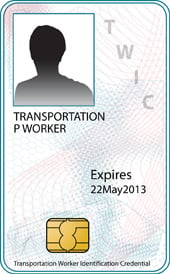- Comparing TWIC and TSA certification for truck drivers
- TWIC Card or TSA Certification: Which Is Better?
The average truck driver doesn't need special security clearances in their day-to-day — but what if you’re interested in hauling loads that will take you to places most civilians can’t tread?
A Transportation Worker Identification Credential (TWIC, also called a TWIC card) and Transport Security Administration (TSA) certification are among the most sought-after security clearances for drivers looking to diversify the freight types they can haul and places they can go.
These certifications don’t just allow drivers to haul cool loads. The more clearances and endorsements a driver has, the more opportunities they have — and the more money they can make.
For years, Anderson Trucking Services (ATS) has been helping carriers and drivers decide which certifications to pursue, and we’re happy to help you do the same.
In this article, we’ll take a deeper look at the similarities and differences between the TWIC card and TSA certification, common misconceptions about the two, and discuss the value of each for carriers and drivers.
By the time you’ve finished reading, you’ll have a better idea of which certification (or both!) are right for you or your fleet, and be well-equipped to pursue them.
Comparing TWIC and TSA Certification for Truck Drivers
A TWIC is a special security clearance issued to workers who require access to restricted areas of maritime ports for the purposes of their work.
TSA certification is a security clearance issued to workers to require access to secure areas of TSA-controlled airports and facilities for their work.
These truck driver security certifications are generally misunderstood and tend to be confused for one another. But TWIC cards and TSA certifications aren’t the same thing, nor are they interchangeable.
To begin our comparison of TWIC and TSA certification, let’s first take a look at their similarities.

TWIC and TSA Certification Similarities
TWIC and TSA certifications are easily confused because of their similarities. TWIC and TSA certifications both:
- Are issued by the TSA to eligible truck drivers who complete their application process
- Grant truck drivers access to restricted areas (and the lucrative freight opportunities therein)
- Require applicants to complete and pass a Security Threat Assessment (STA)
An STA is an extensive background check performed when an individual needs access to restricted areas to perform their job duties.
This assessment confirms that the applicant has represented their identity truthfully and ensures they aren’t a security threat before granting access to restricted areas.
These certifications aren’t free to obtain, and while the total cost of each can vary, the fee is typically nominal ($125.25 for TWIC; the cost of a TSA STA can vary) compared to the high-paying freight opportunities they afford the holder.
TWIC and TSA Certification Differences
The main difference between a TSA certification and a TWIC card is that they apply to different parts of the transportation industry.
Put generally, a TWIC card grants drivers access to secure areas of maritime ports, while a TSA certification grants access to secure areas of airports.
(However, it should be noted that TSA certification is typically not needed for drivers picking up already-cleared freight from an airport.)
The two also have different eligibility prerequisites, processes, and fees.
TWIC
- Only grants access to secure areas of maritime facilities or vessels regulated by the Maritime Transportation Security Act (MTSA) of 2002.
- Only U.S. citizens, lawful permanent residents, or nonimmigrant aliens who meet specific requirements are eligible.
- Costs $125.25 for drivers to obtain, and must be renewed for a $60 fee after five years.
- Is considered a valid form of government-issued photo identification, like a U.S. passport or driver’s license.
- Can be used to obtain TSA PreCheck status at no additional cost.
- Visit the TSA's website to start the application process and find more information.

TSA
- Only grants access to secure areas of TSA-controlled airports and facilities
- Only drivers employed by carriers that are Indirect Air Carrier (IAC)-certified are eligible.
- Carriers become IAC-certified by submitting an application through the TSA's Indirect Air Carrier Management System and working with a TSA Principal Security Inspector throughout the process. Carriers must renew their IAC certification annually.
- Costs nothing for drivers to obtain and renew. The required STA does have an associated fee, which can vary.
- Is not considered a valid form of government-issued photo identification.
- Cannot be used to obtain TSA PreCheck status.
- Once a driver has confirmed their employer is IAC-certified, apply for a New or Renewal Security Threat Assessment through the TSA to start the certification process.
TWIC and TSA Certification Misconceptions
You could also call this section “What TWIC and TSA Certifications Aren’t.”
For starters, TWIC and TSA certifications aren’t interchangeable with each other. A driver with a TWIC card does not automatically have TSA certification; a driver with TSA certification does not automatically have a TWIC card.
They’re also not interchangeable with other security clearances, such as those issued by the Department of Defense (DOD) or other government agencies.
If you’re traveling as a civilian — driving your family car, for example, or flying for a vacation — TWIC cards and TSA certifications cannot be used in place of a driver’s license or passport.
They also don’t grant the holder any benefits or special treatment during civilian travel security processes, such as airport security/TSA lines or security checks for cruise ship travelers, with the exception of active TWIC cardholders who choose to use those credentials to obtain TSA PreCheck when taking a flight.

TWIC Card or TSA Certification: Which Is Better?
“Better” is really in the eye of the beholder — or the certification holder, in this case. Different drivers will find different values in these certifications.
A trucking company in a landlocked state will likely get more use out of TSA certification. A new company in a port city will want their drivers to get TWIC cards. An owner-operator along the East Coast would find benefit in both.
In all these cases, the question of which certification is better is relative to their circumstances.
Still, there are some objective facts that carriers and drivers may want to consider before choosing which certification to pursue first.
Personnel involved in maritime transportation, including truck drivers, must hold TWIC cards to access restricted areas as required for their work, such as ports, terminals, and other maritime facilities.
Without a TWIC card, drivers can’t access these authorized locations without an authorized escort. There is often a fee associated with arranging an escort, and drivers are at the mercy of the escort’s schedule — if the port in question allows escorts at all, which some don’t.
That means investing in TWIC cards for drivers can ultimately help companies that regularly conduct business at ports (or want to branch out into this lucrative transportation industry sector) save time and money.
A TWIC card is more expensive to obtain than a TSA certification, but after hauling a few well-paying loads, many drivers say TWIC essentially pays for itself.

For its part, a TSA certification grants drivers the ability to move freight in and out of TSA-controlled airports, facilities, and aircraft — jobs that often pay more than standard freight loads.
TSA certification requires drivers to undergo an STA, which does have a fee. However, because the eligibility prerequisite falls on the carrier (i.e., IAC certification) many carriers cover the cost of their drivers’ STAs to get them TSA-certified.
TSA certification also allows carriers to better serve customers by cutting out any “middlemen” and transporting freight directly onto an aircraft. This saves everyone time, money, and effort.
Ultimately, there is no “better” truck driver certification, just different ones. The choice of which to pursue yourself or for your drivers comes down to your geographic area, the market you serve, and your goals for diversifying the freight you can haul.
In fact, why choose at all? Companies operating in major metropolitan areas with both maritime and air freight markets would likely benefit from having both TWIC and TSA driver certifications.
Haul More Freight, Make More Money
Many carriers and drivers pursue security clearances and certifications to diversify their capabilities and make more money.
TWIC and TSA certifications are among the most popular driver certifications available. Both grant the holder access to haul freight to and from secure or restricted areas.
While they have a few key differences, such as the types of areas to which they grant access (ports vs. airports), TWIC and TSA certifications are both valuable additions to a driver’s resume and open up new opportunities to haul well-paying loads.
And there’s more good news where that came from: It isn’t an “either/or” situation. Drivers can and do hold both TWIC and TSA certifications.
But if you find yourself struggling to choose which to pursue first, consider the freight market in your service areas and the untapped opportunities therein. Your proximity to air or sea freight will determine whether TWIC or TSA is the best first move for you.
Interested in more ways to diversify your loads? ATS developed a load board app to help carriers and drivers book well-paying freight faster.
ATS FreightMatch’s responsive search lets you filter your load searches through over 15 criteria, including the rate per mile, length of haul, total pay and trailer type. Check it out and request your invitation to start browsing!
If you have questions about driver certifications and safety clearances, diversifying your capabilities, or any other transportation industry topics, feel free to reach out to the ATS team. We’re always happy to share our knowledge and help you make the best decision for your business.
.png)



